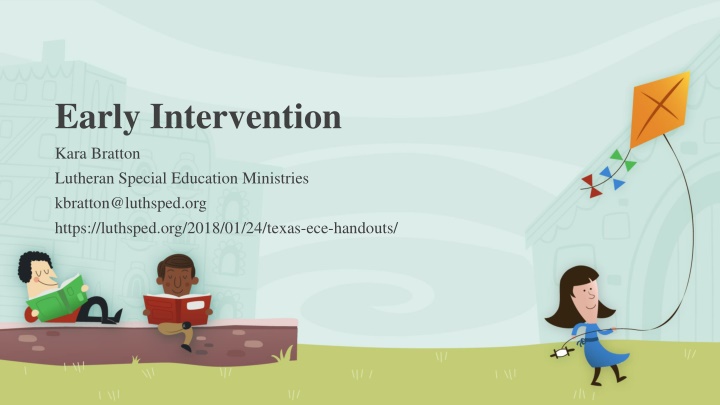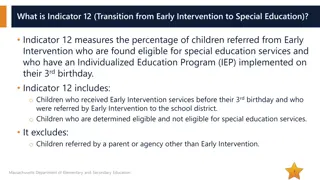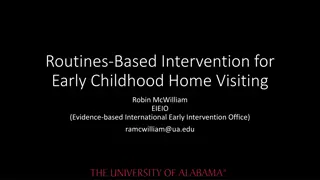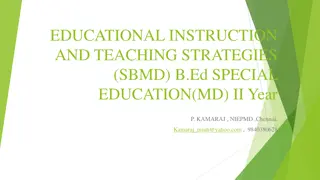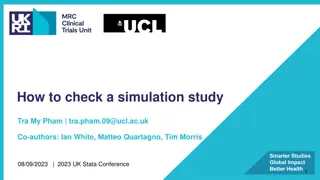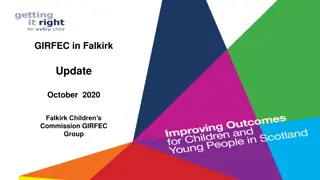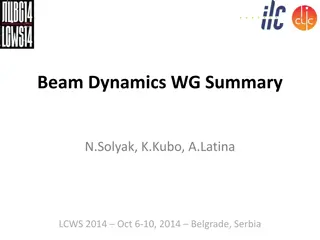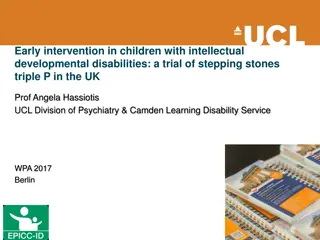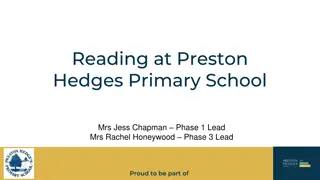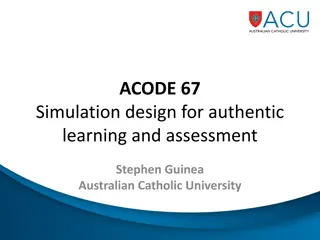Early Intervention and Reading Simulation Resources for Children
Explore valuable resources for early intervention and reading simulation to support children's learning and development. Topics covered include language delays, reading difficulties, and effective strategies for preschoolers. Dive into helpful information and tools provided by Lutheran Special Education Ministries and other reputable sources.
Uploaded on Sep 17, 2024 | 0 Views
Download Presentation

Please find below an Image/Link to download the presentation.
The content on the website is provided AS IS for your information and personal use only. It may not be sold, licensed, or shared on other websites without obtaining consent from the author.If you encounter any issues during the download, it is possible that the publisher has removed the file from their server.
You are allowed to download the files provided on this website for personal or commercial use, subject to the condition that they are used lawfully. All files are the property of their respective owners.
The content on the website is provided AS IS for your information and personal use only. It may not be sold, licensed, or shared on other websites without obtaining consent from the author.
E N D
Presentation Transcript
Early Intervention Kara Bratton Lutheran Special Education Ministries kbratton@luthsped.org https://luthsped.org/2018/01/24/texas-ece-handouts/
Reading Simulation When you see: Pronounce as: q d or t z m p b b p ys er a, as in bat e, as in pet e, as in pet a, as in bat http://www.pbs.org/wgbh/misunderstoodminds/experiences/readexp1a.html
Reading Simulation Passage: We pegin our qrib eq a faziliar blace, a poqy like yours enq zine. Iq conqains a hunqraq qrillion calls qheq work qogaqhys py qasign. Enq wiqhin each one of qhese zany calls, each one qheq hes QNA, Qhe QNA coqe is axecqly qhe saze, a zess-broquceq rasuze. So qhe coqe in each call is iqanqical, a razarkaple puq veliq claiz. Qhis zeans qheq qhe calls are nearly alike, puq noq axecqly qhe saze. Qake, for insqence, qhe calls of qhe inqasqines; qheq qhey're viqal is cysqainly blain. Now qhink apouq qhe way you woulq qhink if qhose calls wyse qhe calls in your prain.
Reading Simulation Here is the translation: We begin our trip at a familiar place, a body like yours and mine. It contains a hundred trillion cells that work together by design. And within each one of these many cells, each one that has DNA, The DNA code is exactly the same, a mass-produced resume. So the code in each cell is identical, a remarkable but valid claim. This means that the cells are nearly alike, but not exactly the same. Take, for instance, the cells of the intestines; that they're vital is certainly plain. Now think about the way you would think if those cells were the cells in your brain. (Excerpt from "Journey into DNA" on the "Cracking the Code" Web site, NOVA Online.)
Reading and Writing Simulation Reading Simulation https://www.understood.org/en/tools/through-your-childs- eyes/player?simq=c07181bd-05a5-466c-aaa0- f54146a9d844&standalone=true&simulation=true Writing Simulation https://www.understood.org/en/tools/through-your-childs- eyes/player?simq=a06af01c-0a60-45c0-b306- 2e8714d05bb4&standalone=true&simulation=true
Risk Indicators for Preschoolers A history of significant language delay or disorder, even if the child currently appears to have age- appropriate language abilities Limited exposure to oral and written language before beginning school A native language other than English A disability that affects oral language acquisition, such as a hearing impairment A significant history of reading difficulties in close family members Oral language difficulties (poor vocabulary, listening comprehension, or grammatical abilities for the child s age)
Risk Indicators for Children in Kindergarten and First Grade Poor phonological/phonemic awareness (inability to rhyme, identify initial and final sounds of spoken words, or to blend and segment one-syllable spoken words) Lack of familiarity with basic print concepts such as (1) print conveys meaning, (2) print is read left to right, and (3) words are separated by spaces Poor knowledge of common letter-sound relationships Difficulty decoding unfamiliar words at the middle or end of first grade, especially as measured by reading of nonsense words such as zat
Risk Indicators for Children in Second and Third Grade Ongoing difficulties with decoding of unfamiliar words Slow, labored, dysfluent reading in grade- appropriate text Poor reading comprehension Poor spelling
Typical Achievements of Children in Phonemic Awareness and Word Decoding Preschool Rudimentary level of phonological awareness (rhyming) Some knowledge of letter names/sounds Some basic print concepts
Typical Achievements of Children in Phonemic Awareness and Word Decoding Kindergarten First Grade Knowledge of all individual letter names and sounds (K) Can identify spoken words with the same initial sound or same final sound (K) More advanced basic print concepts (e.g., printed words are separated by spaces) (K) Can blend individual phonemes to form a one-syllable word (Gr. 1) Can segment a spoken one-syllable word into individual phonemes (Gr. 1) Knowledge of sounds for some common letter patterns, such as sh, ch, th, ee, oo, ay (Gr. 1) Can decode a wide variety of one-syllable words (e.g., fast, bike, shook, stay, chip ) (Gr. 1)
Typical Achievements of Children in Phonemic Awareness and Word Decoding 2nd-3rdGrade Increasing knowledge of sounds for common letter patterns (Gr. 2) Increasing skill in decoding two-syllable and multisyllable words (Gr. 2) Knowledge of sounds for common prefixes ( in-, re-, un- ) and suffixes ( - tion, -ment, -ness ) (Gr. 2 3) Use knowledge about root words and morphemic relationships to read multisyllable words (Gr. 3) Have skills for decoding accurately and quickly most words, including multisyllable words (Gr. 3)
Typical Achievements of Children in Reading Fluency Preschool Few children can read at this age, so reading fluency is nonexistent for most children. Kindergarten First Grade Few kindergarten children are reading text fluently, but most can name letters quickly, automatically, and accurately by the end of kindergarten. First graders are developing accuracy in decoding one-syllable words but may have some difficulty reading with expression or attending to punctuation (e.g., child may fail to pause at commas and periods). Children read at least 40 words correctly per minute in grade-appropriate texts by the end of first grade.*
Typical Achievements of Children in Reading Fluency 2nd-3rdGrade Prime time for the development of fluency children are not only accurate but increasingly fast and automatic in reading grade-appropriate texts Read aloud with good expression and with attention to punctuation Recognize and use larger letter patterns (e.g., -ight and -ear ) in reading words Read at least 90 words correctly per minute in grade-appropriate texts by the end of second grade* Read at least 110 words correctly per minute in grade-appropriate texts by the end of third grade*
Typical Achievements of Children in Writing and Spelling Preschool Little to no spelling ability, except perhaps ability to spell own name Limited understanding of basic print concepts. Children may copy words or letters backwards, write from right to left instead of left to right, etc. Demonstrate interest in drawing and writing Understand that writing conveys meaning May pretend write messages or stories, using a variety of scribbles, drawings, and letters or letter-like forms
Typical Achievements of Children in Writing and Spelling Kindergarten First Grade Spell first and last name correctly (K) Use some letter-sound relationships correctly in spelling, especially first and last letter of a word (K) Demonstrate increased understanding of basic print concepts (write from left to right on a page) (K) Represent most sounds in words correctly, so spelling is increasingly phonetic and recognizable even if not conventionally correct (Gr. 1) Spell some common irregular words correctly (e.g., the, of, are) (Gr. 1) Use some very basic mechanical conventions (capitalize first word of a sentence and use ending punctuation) (Gr. 1) Write readable short compositions with a clear beginning, middle, and end (Gr. 1)
Typical Achievements of Children in Writing and Spelling 2nd-3rdGrade Increased ability to spell words in a conventionally correct way, using not only knowledge of letter sounds but also knowledge of common letter patterns, spelling rules, and morphemic relationships (Gr. 2 3) Spell correctly many common irregular words and some common homophones (e.g., to, two, too ) (Gr. 2 3) Write in complete and varied sentences (Gr. 2 3) Elaborate details and write longer compositions (Gr. 2 3)
Typical Achievements of Children in Writing and Spelling 2nd-3rdGrade continued Increased use of mechanical conventions in writing (e.g., apostrophe in contractions and to show possession, capitalization of proper nouns and titles) (Gr. 2 3) Use some revision of content, as well as editing of mechanics (Gr. 2 3) Demonstrate increased organization of content in written work (Gr. 2 3) Produce a variety of types of writing (e.g., stories, short reports, reading responses) (Gr. 3)
Typical Achievements of Children in Comprehension Preschool Age-appropriate listening comprehension and vocabulary knowledge (Reading comprehension is nonexistent or very limited in most children, because most children cannot yet read.)
Typical Achievements of Children in Comprehension Kindergarten First Grade Beginning to develop reading skill, but listening remains the main vehicle for developing comprehension and vocabulary in most children Some knowledge of comprehension strategies such as summarization, prediction, and using context to infer word meanings, but these are more readily applied in listening than in reading Can answer correctly literal, inferential, and vocabulary questions about grade- appropriate texts Can retell in own words material from grade-appropriate texts
Typical Achievements of Children in Comprehension 2nd-3rdGrade Children s own reading increasingly becomes a vehicle for developing comprehension abilities and vocabulary knowledge, but listening also remains important. Can increasingly apply comprehension strategies to their own reading as well as to listening Can answer correctly literal, inferential, and vocabulary questions about grade- appropriate texts Can retell in own words material from grade-appropriate texts
Reading Strategies http://www.fcrr.org/for-educators/sca.asp http://www.pbs.org/launchingreaders/ http://www.readtheory.org Starfall: http://more.starfall.com/m/welcome/index/load.htm Get Ready to Read Games: http://www.getreadytoread.org/skill-building-activities/online-games Skill Building Activities: http://www.getreadytoread.org/skill-building-activities
Reading Strategies Finger Tapping for Spelling Sound Cards & Blending
Reading Strategies Syllabification The Fantastic Syllable Division Word Book (orton-gillingham.com) Red words/Non-phonetic words
Reading Strategies Auditory Practice
Math Simulation https://www.understood.org/en/tools/through-your-childs- eyes/player?simq=d7e339d7-7c55-4fd0-bef6- 94b1a640d9dc&standalone=true&simulation=true
Signs of Math Difficulties Warning Signs in Preschool or Kindergarten Has trouble learning to count, especially when it comes to assigning each object in a group a number Has trouble recognizing number symbols, such as making the connection between 7 and the word seven Struggles to connect a number to a real-life situation, such as knowing that 3 can apply to any group that has three things in it 3 cookies, 3 cars, 3 kids, etc. Has trouble remembering numbers, and skips numbers long after kids the same age can count numbers and remember them in the right order Finds it hard to recognize patterns and sort items by size, shape or color Avoids playing popular games like Candy Land that involve numbers, counting and other math concepts
Signs of Math Difficulties Warning Signs in Grade School Has trouble recognizing numbers and symbols Has difficulty learning and recalling basic math facts, such as 2 + 4 = 6 Struggles to identify +, and other signs and use them correctly May still use fingers to count instead of using more sophisticated strategies Has trouble writing numerals clearly or putting them in the correct column
Signs of Math Difficulties Has trouble coming up with a plan to solve a math problem Struggles to understand words related to math, such as greater than and less than Has trouble telling his left from his right, and has a poor sense of direction Has difficulty remembering phone numbers and game scores Avoids playing games like Risk that involve number strategy Has trouble telling time
Math Strategies Using concrete examples that connect math to real life, to strengthen your child s number sense. Examples: sorting buttons or other familiar objects. Using visual aids when solving problems, including drawing pictures or moving around physical objects which teachers refer to as manipulatives. Assigning manageable amounts of work so your child won t feel overloaded. Reviewing a recently learned skill before moving on to a new one, and explaining how the skills are related.
Math Strategies Subitizing Subitizing is the ability to recognize the number of briefly presented items without actually counting. https://www.youtube.com/watch?v=nLsIrNXxZWo
Math Strategies (from Bob Sornson) One-to-one correspondence (start with single digit numbers before moving on to double digits) Have number line on floor, stepping stones, with dots, not number symbols (tape, chalk if outside, on paper plates, etc) Ask child to take steps forward, counting as he/she goes, connecting word to number of dots Go back to start and ask child to take x number of steps forward, back to start, repeat with different number Goal is for child to feel the difference between numbers, not associate with written number symbol, building number sense Move stepping stones to varying distances apart or make it so child has to cross midline
Math Strategies (from Bob Sornson) One-to-one correspondence Ask child to catch x number of beanbags Child counts while catching and stops at appropriate number Variation: Have child hold all beanbags until appropriate number is caught so the difference in weight is sensed between catching 2 beanbags and 6 beanbags Variation: Have child stand on a balance board while catching, helps improve attention and skill retention through vestibular stimulation
Math Strategies (from Bob Sornson) Understanding Combinations Establish a target for throwing (hula hoop, box, etc) Ask the child to pick up x number of beanbags (or other object) and throw them into the target Once all objects are thrown, ask child to identify how many are in the target and how many are not Allow child to make connection that the two numbers combine to make original number on their own
Math Strategies (from Bob Sornson) Understanding Combinations Use the previously mentioned numberline with dots, no number symbols Ask the child to move to a certain number on the number line Once there, ask the child how many more steps it will take to get to number x Let him or her look at the numbers, think, and answer before prompting to take the steps (while counting) and see if he or she was correct Variation: As child develops number sense, do this activity with number symbols rather than dots
Math Strategies (from Bob Sornson) Understanding Combinations Use same numberline again Ask child to take x steps forward then x steps backward and have child say where he or she is now Variation: Use number symbols rather than dots as child progresses
Math Strategies http://illuminations.nctm.org/Default.aspx http://illuminations.nctm.org/unit.aspx?id=6136 http://illuminations.nctm.org/Activity.aspx?id=3564 (online game) http://www.nctm.org/Classroom-Resources/ARCs/Counting-Strategies/ http://www.nctm.org/Classroom-Resources/ARCs/Building-Fluency-Using-Combinations-of- 10/ http://earlylearningfoundation.com/publications/ Math Moms and Dads program http://www.doe.virginia.gov/instruction/mathematics/elementary/number_sense_module/nn s_modules_2012.pdf
Working Memory Working memory difficulties common in students with learning disabilities and ADHD Working memory is the ability to hold AND manipulate information over short periods of time
Working Memory Average adults can only hold 6-7 units of information in working memory (units may be comprised of individual elements grouped together) Typical 4 year olds may hold 2 units of information in working memory Typical 15 years old may hold 4-5 units of information in working memory
Working Memory Strategies Minimize background noise involving language Rehearse contents of working memory for retention Use visuals and memory aids but also teach students where to locate information and how to use Reduce working memory loads and repeat important information Once information is lost from working memory, it s GONE and can not be recovered Resource: Working Memory & Learning: A Practical Guide for Teachers by Susan E. Gathercole & Tracy Packiam Alloway
Make the First Five Count Ages and Stages Questionnaire FREE online screening tool from Easter Seals for children birth through age 5 Parents complete questions about child s communication, gross and fine motor, problem solving and social skills May be updated to see progress https://www.asqonline.com/family/993-screening-family-access-open-asq-3- english/start CDC Milestone Tracker- https://www.cdc.gov/ncbddd/actearly/milestones-app.html
Documentation Sample forms for intervention progress and meeting documentation (see forms on website link) DIBELS PELI for Early Childhood https://dibels.org/peli.html Essential Skills Inventory from Bob Sornson http://earlylearningfoundation.com/publications/ Preschool essential skills also available from website link at beginning of presentation
Parent Resources CDC Milestone Moments https://www.cdc.gov/ncbddd/actearly/pdf/parents_pdfs/MilestoneMomentsEng508.p df https://www.cdc.gov/ncbddd/actearly/pdf/checklists/all_checklists.pdf CDC How to Help Your Child and How to Talk with the Doctor https://www.cdc.gov/ncbddd/actearly/pdf/parents_pdfs/CDC_LTSAE-Concerned- about-Development_Eng.pdf Tips for Talking with Parents about Developmental Concerns https://www.cdc.gov/ncbddd/actearly/pdf/parents_pdfs/TipsTalkingParents.pdf
Stay in Touch! Luthsped.org Sign up for our free e-newsletters Always available for FREE consultations Available for professional development for schools and churches
